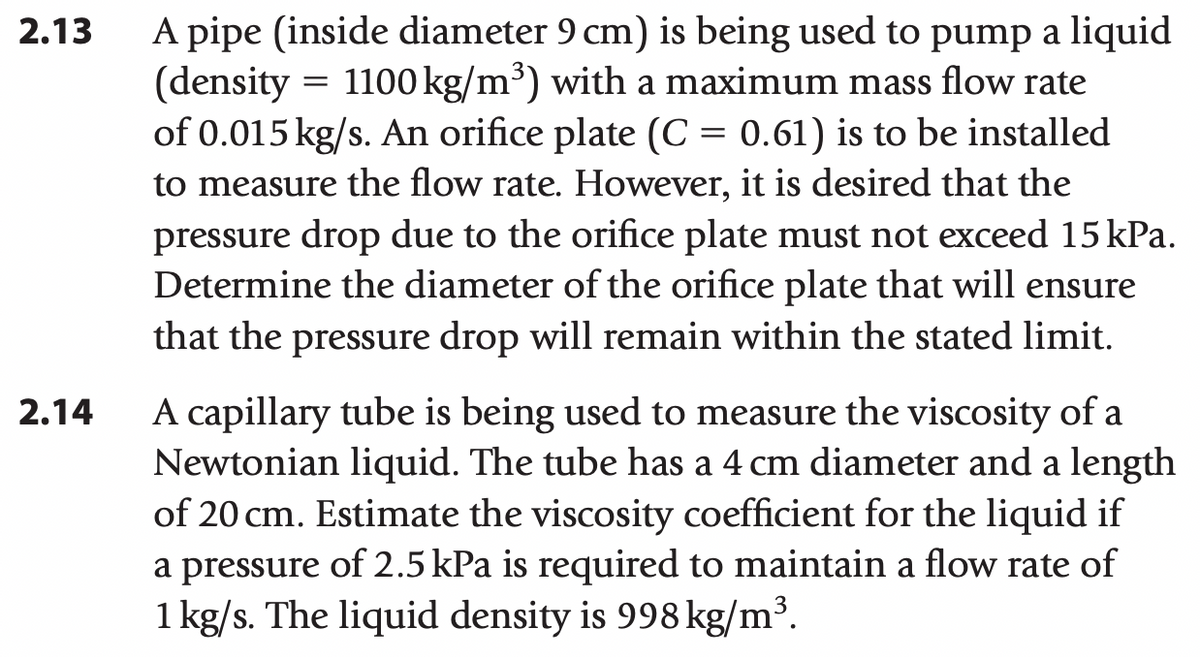2.13 A pipe (inside diameter 9 cm) is being used to pump a liquid (density = 1100 kg/m³) with a maximum mass flow rate of 0.015 kg/s. An orifice plate (C = 0.61) is to be installed to measure the flow rate. However, it is desired that the pressure drop due to the orifice plate must not exceed 15 kPa. Determine the diameter of the orifice plate that will ensure that the pressure drop will remain within the stated limit.
2.13 A pipe (inside diameter 9 cm) is being used to pump a liquid (density = 1100 kg/m³) with a maximum mass flow rate of 0.015 kg/s. An orifice plate (C = 0.61) is to be installed to measure the flow rate. However, it is desired that the pressure drop due to the orifice plate must not exceed 15 kPa. Determine the diameter of the orifice plate that will ensure that the pressure drop will remain within the stated limit.
Introduction to Chemical Engineering Thermodynamics
8th Edition
ISBN:9781259696527
Author:J.M. Smith Termodinamica en ingenieria quimica, Hendrick C Van Ness, Michael Abbott, Mark Swihart
Publisher:J.M. Smith Termodinamica en ingenieria quimica, Hendrick C Van Ness, Michael Abbott, Mark Swihart
Chapter1: Introduction
Section: Chapter Questions
Problem 1.1P
Related questions
Question

Transcribed Image Text:2.13
2.14
A pipe (inside diameter 9 cm) is being used to pump a liquid
(density = 1100 kg/m³) with a maximum mass flow rate
of 0.015 kg/s. An orifice plate (C = 0.61) is to be installed
to measure the flow rate. However, it is desired that the
pressure drop due to the orifice plate must not exceed 15 kPa.
Determine the diameter of the orifice plate that will ensure
that the pressure drop will remain within the stated limit.
A capillary tube is being used to measure the viscosity of a
Newtonian liquid. The tube has a 4 cm diameter and a length
of 20 cm. Estimate the viscosity coefficient for the liquid if
a pressure of 2.5 kPa is required to maintain a flow rate of
1 kg/s. The liquid density is 998 kg/m³.
Expert Solution
This question has been solved!
Explore an expertly crafted, step-by-step solution for a thorough understanding of key concepts.
Step by step
Solved in 3 steps

Recommended textbooks for you

Introduction to Chemical Engineering Thermodynami…
Chemical Engineering
ISBN:
9781259696527
Author:
J.M. Smith Termodinamica en ingenieria quimica, Hendrick C Van Ness, Michael Abbott, Mark Swihart
Publisher:
McGraw-Hill Education

Elementary Principles of Chemical Processes, Bind…
Chemical Engineering
ISBN:
9781118431221
Author:
Richard M. Felder, Ronald W. Rousseau, Lisa G. Bullard
Publisher:
WILEY

Elements of Chemical Reaction Engineering (5th Ed…
Chemical Engineering
ISBN:
9780133887518
Author:
H. Scott Fogler
Publisher:
Prentice Hall

Introduction to Chemical Engineering Thermodynami…
Chemical Engineering
ISBN:
9781259696527
Author:
J.M. Smith Termodinamica en ingenieria quimica, Hendrick C Van Ness, Michael Abbott, Mark Swihart
Publisher:
McGraw-Hill Education

Elementary Principles of Chemical Processes, Bind…
Chemical Engineering
ISBN:
9781118431221
Author:
Richard M. Felder, Ronald W. Rousseau, Lisa G. Bullard
Publisher:
WILEY

Elements of Chemical Reaction Engineering (5th Ed…
Chemical Engineering
ISBN:
9780133887518
Author:
H. Scott Fogler
Publisher:
Prentice Hall


Industrial Plastics: Theory and Applications
Chemical Engineering
ISBN:
9781285061238
Author:
Lokensgard, Erik
Publisher:
Delmar Cengage Learning

Unit Operations of Chemical Engineering
Chemical Engineering
ISBN:
9780072848236
Author:
Warren McCabe, Julian C. Smith, Peter Harriott
Publisher:
McGraw-Hill Companies, The